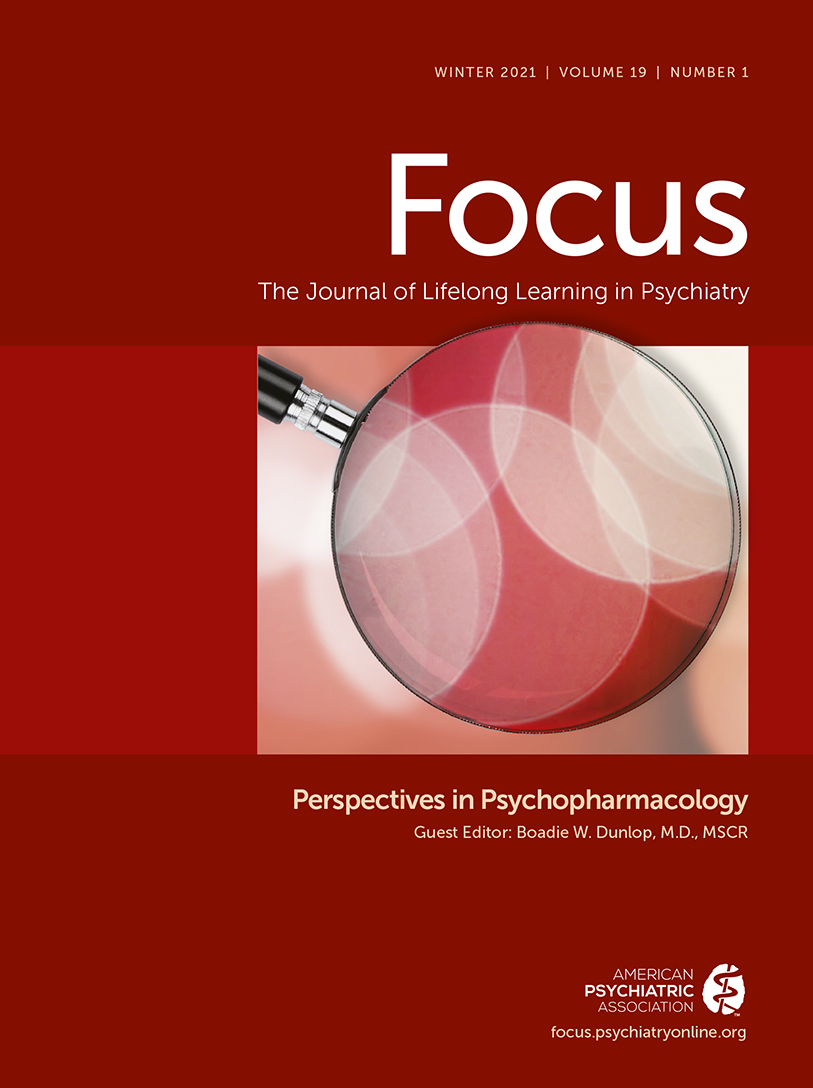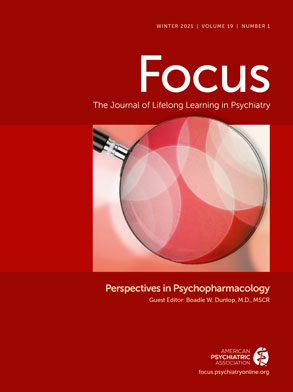A decade ago, psychiatry was awash with pessimistic predictions about the future of pharmacotherapy for mental illnesses. With too many potential targets and no coherent pathophysiological models, “Big Pharma” was pulling in its sails, giving up on neuropsychiatric drug discovery (
1). Psychiatrists and patients were going to be stuck with the same old drugs for a long time to come.
What a difference a decade makes. The recent pace of discovery has left many clinicians feeling a bit at sea, struggling to keep up with developments across the pharmacopeia. Over the past 5 years, entirely new classes of medications have been marketed in psychiatry, targeting glutamate, neurosteroid, melanocortin, and orexin receptors, as well as vesicular transporters. Other developments include numerous new formulations of medications that alter absorption profiles and effective half-lives (
2,
3), prodrugs, psychedelic- and MDMA-assisted psychotherapy, and pharmacogenomic decision support tools. All of these innovations make discussion of monoamine transporters and receptors seem old hat, almost as much as talking about monoamine oxidase inhibitors (MAOIs) and barbiturates did 20 years ago.
This issue of
Focus aims to chart a course through these pharmaceutical currents. Our lead article, by Herman Meltzer, M.D., and Erick Gadaleta, D.O., is a tour de force conceptualization of the marketed antipsychotics (
4). By combining pharmacodynamic principles with important take-aways from antipsychotic clinical trials, Dr. Meltzer challenges us to rethink our understanding of the utility of the various atypical antipsychotics and potential approaches to treatment-resistant schizophrenia. The richness of Dr. Meltzer’s review provides insights that emerge beyond one’s initial reading of the text; this is an article that rewards clinicians the more deeply they engage with it.
An unfortunate consequence of antipsychotic treatment, tardive dyskinesia (TD) has recently acquired new promise in the form of the reversible vesicular monoamine transporter-2 (VMAT-2) inhibitors. Although tetrabenazine has been available for decades, pharmacokinetic factors have limited its clinical application for TD. Drs. Sarah Debrey and David Goldsmith (
5) provide a thorough review of the pharmacology and clinical utility of deutetrabenazine and valbenazine, two newly marketed VMAT-2 inhibitors. The authors also discuss how these newer agents are important developments in our long battle against TD, and their position relative to the old standby clozapine and the novel approaches of neurostimulation. Clinicians treating patients who have received antipsychotics will be well informed by this outstanding review.
Metabolic disruptions and their consequences are another unhappy complication of antipsychotic treatment and reduce both lifespan and quality of life. Cardiovascular diseases are common comorbidities among psychiatric patients, who may be unwilling or unable to obtain primary care treatment. For such patients, mental health clinicians need to take an active role in monitoring and addressing these problems. In her overview, Dr. Martha Ward (
6) provides a very practical and impactful approach that mental health clinicians can easily apply to improve the cardiovascular health of their patients. First-step interventions such as metformin to address glucose dysregulation and tobacco addiction treatments are aspects of patient care that psychiatrists ought to become comfortable with, considering the fractured nature of health care in the United States.
Sexual dysfunction, particularly hypoactive sexual desire disorder (HSDD), is a significant contributor to reduced quality of life and relationship stress. Drs. Gabriela Pachano Pesantez and Anita Clayton (
7) provide a review of the diagnostic considerations and treatment options for this common and challenging-to-treat condition. Flibanserin and bremelanotide are two newly marketed medications for HSDD, which possess unique pharmacodynamic actions and issues related to tolerability. This article will help guide clinicians in the use of these new agents vis-à-vis other potential interventions, such as testosterone or psychotherapy.
In the realm of attention-deficit hyperactivity disorder, it hasn’t been the emergence of new mechanisms but rather the astonishing number of new formulations that challenge clinicians’ pharmacological competence. Erupting like so many flittering flying fish, transiently capturing our attention before disappearing again beneath the relentless flow of information, the novel stimulant formulations have clinical utilities and differentiating characteristics that may be hard for prescribers to retain in memory. Dr. Ann Childress (
8) provides a structured approach for thinking through these new formulations and their pharmacokinetically-driven clinical applications. The generic names for these various reformulations are highly overlapping and make retention by the clinician even more challenging; thus, for this article, we have deviated from our usual practice and permitted the use of branded drug names for clarity.
As pharmacologic complexity increases in psychiatry, it seems clear that residency training programs are going to need to commit even more time and expertise to psychopharmacology education. Dr. Jeffrey Rakofsky (
9) reviews the advances made to date in this area, including novel uses of technologies and supervision methods. Interactive teaching, in which the learner is required to think through the pros and cons of applying specific medications to specific patients will need to become a bigger part of the learning process. Currently, trainees usually learn about medications in the abstract and then at some later date attempt to recall that information as they haphazardly encounter patients for whom it is applicable. Greater learning consolidation could be achieved if, shortly after participating in didactic instruction around the theoretical aspects of pharmacology, trainees engaged in computerized simulations programmed for the application of recently acquired drug knowledge. Trainees also need to understand the importance of committing to lifelong learning focused on updating and reinforcing one’s knowledge in psychopharmacology, through “learning how to learn” on one’s own. We must instill in our trainees how to actively and thoughtfully approach claims about the efficacy, safety, mechanism, and metabolism of new medications, for the pace of discovery is unlikely to slow.
Our Ask the Expert column (
10), coauthored by Dr. Alexander Bodkin and me, provides a throwback amid this exciting rush of new medications and their associated mechanisms. By offering an approach for clinicians to go “backwards” from current, often multidrug, regimens to the old mechanism of monoamine oxidase inhibition, this column reminds us that newer does not automatically equate to better. Sure, it would be easier if we did not have to think about MAOIs anymore, given all their interactions and potential for serious adverse reactions. We could commit our pharmacologic learning efforts to the newer, safer, and easier-to-use medicines. But the successful MAOI treatment of just one patient who has failed numerous other drug mechanisms can reveal the value in knowing and retaining as much pharmacologic knowledge as possible. Until these disorders that plague our patients can be distilled to their underlying pathophysiology, accompanied by targeted therapeutics that reverse that pathophysiology, we are going to need all our tools to optimize our patients’ outcomes.
Conclusion
To perceive accurately, to reason sensibly, to feel rightly, and to act purposefully, aligned with one’s truest sense of self.
This is the goal of mental health treatment, and for many patients psychopharmacology is an indispensable support for that journey. To best aid our patients, we must work continually to deepen our knowledge of our medicines, including their mechanisms, kinetics, interactions, harms, and comparative advantages. There is no shortcut to possessing such knowledge; it is acquired only through study and practice. Our patients look to us for this expertise. As physicians, understanding to the fullest of our ability the workings of the chemicals we prescribe is a moral imperative. This issue of Focus aims to support your growth as a psychopharmacologist, and I hope you come away enriched for engaging with the knowledge contained within.

